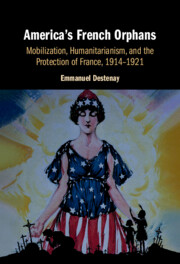Book contents
- America’s French Orphans
- America’s French Orphans
- Copyright page
- Dedication
- Contents
- Figures
- Maps
- Preface
- Acknowledgments
- Note on the Text
- Select Biographies of Those Involved in Providing Relief to France’s Orphans
- Introduction
- Chapter 1 Rescuing and Sheltering
- Chapter 2 Mobilizing Support for France’s Fatherless Children
- Chapter 3 Defending the Future of France
- Chapter 4 Writing in Wartime
- Chapter 5 Peace, Remobilization, and Memorialization
- Chapter 6 Rebuilding Devastated France
- Conclusion
- Appendices
- Bibliography
- Index
- References
Bibliography
Published online by Cambridge University Press: 24 October 2024
- America’s French Orphans
- America’s French Orphans
- Copyright page
- Dedication
- Contents
- Figures
- Maps
- Preface
- Acknowledgments
- Note on the Text
- Select Biographies of Those Involved in Providing Relief to France’s Orphans
- Introduction
- Chapter 1 Rescuing and Sheltering
- Chapter 2 Mobilizing Support for France’s Fatherless Children
- Chapter 3 Defending the Future of France
- Chapter 4 Writing in Wartime
- Chapter 5 Peace, Remobilization, and Memorialization
- Chapter 6 Rebuilding Devastated France
- Conclusion
- Appendices
- Bibliography
- Index
- References
- Type
- Chapter
- Information
- America's French OrphansMobilization, Humanitarianism, and the Protection of France, 1914–1921, pp. 227 - 265Publisher: Cambridge University PressPrint publication year: 2024

